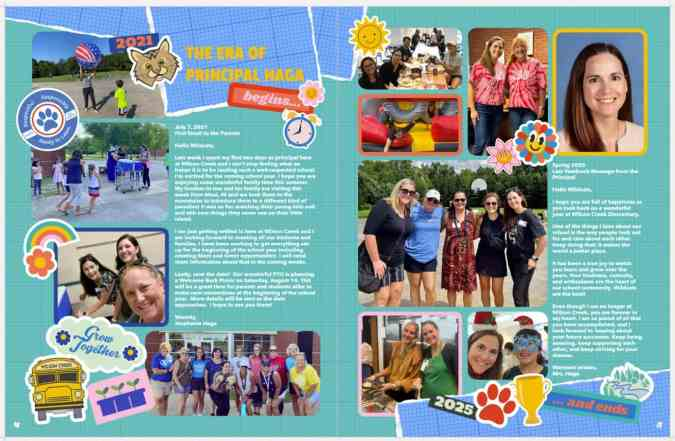
Erikalinpayne
April 29, 2025
2
Min Read Time

No one reads yearbook stories. Sound familiar? I felt that way in my first five years advising. Focusing on photojournalism was almost an act of rebellion against the genius who mentored me in my high school’s newsroom. Yes, pictures are worth a thousand words and all that. By adding writing to your yearbook pages, you give names to faces and intent to actions. It’s more than so-and-so on the thing doing the thing; it’s context and clarity. It's a change for the better.
I’ve said it for years because my aforementioned high school adviser brainwashed me (in a good way): Content drives design. If you plan on increasing your yearbook’s written content, learn how to design with copy.

Headlines are a great way to connect yearbook spreads back to the theme. On a spread about robotics, push yourself to make the main verbal entry point read more than “Robotics.” Your headline font, weight, color, and placement are just as important as the dominant photo.
While not every topic may need a story, (nearly) every photo deserves a caption. Captions are entry-level writing opportunities. Compare the two spreads below. They are from the same yearbook. One is captions only; the other has a story.
The captions are close to the photos they complement. The story connects to the headline and subheadline.
As an adult, it can be tough to approach another adult and have a conversation (cool mom at the playground, I’m looking at you). Likewise, getting students to approach their peers isn’t the easiest skill to teach. As with all skills, take the easy +1 approach: start small, master that skill, and add another.
A progression, like the one below, builds confidence while building familiarity.
The heading says it all. Advisers or the editorial board select a question, and yearbook students ask four non-yearbook students the QOTD.
Yearbook creators are encouraged to start with their peer groups and branch out. The only caveat is that they cannot ask a student a QOTD twice until everyone has had a chance. No repeats. You can track this with a BOLO (Be on the Lookout) board, via a Google Sheet fed by a Google Form, or with your roster.
Do the math with me for a second: if six yearbook students each interviewed four students daily, that would be 120 student voices added to your yearbook in a week. With a larger staff of 18, that’s 360 new voices. Use these as Q&A moments in your portrait section or sidebars through athletics, arts, and student life spreads.
With those figures, you could get a meaningful quote from nearly everyone on campus each quarter.
Repetition builds skills, and we educators know that. In the yearbook classroom or club space, the work of photoshoots, layout design, and marketing sometimes overshadows the process of creating. Take time to teach, practice, and evaluate your team’s skills. Here are a few ideas:
The key to a good yearbook interview is to have good questions. While there are hundreds of lists on the interwebs (we list some of our favs below), tailoring the interview to the subject will always give you the best material.
The best way to prep is to craft questions using the Five Common Topics: definition, comparison, relationship, circumstance, and testimony.
Once you have a list of questions—“Give me a quote for the yearbook” does not count—ask them!
The late Casey Nicols inspired a love of focus groups in me. As a journalism mentor, he encouraged me to bring in clubs or teams at lunchtime and interview the group. There was strength in numbers for them, as interviews were new for our yearbook staff. And our staff received some of the best quotes because they would play off each other.
As a result, their writing became interesting. Students read it. It became the expectation.
Remember, easy +1. If there is no writing in your yearbook, add captions. Play with sentence structure so it’s not always subject-verb-adverb. Add a prepositional opener. Make it a complex sentence. Then
You don’t have to do it all. Ever. Tell your community’s story your way.
Use these lists of interview questions for creating QOTD, practice interviews, and as launch pads for longer form copy.
You can even have students rank their favorite and least favorite questions. Make sure they have a reason why. Re-write the “bad” questions and craft follow-ups for the helpful ones.